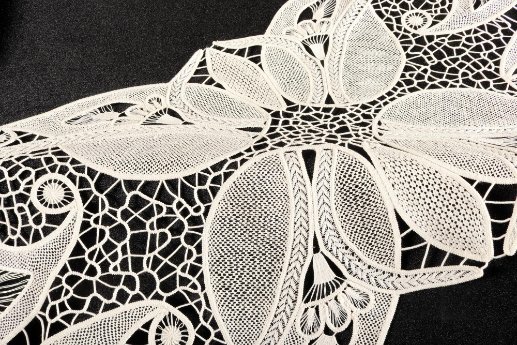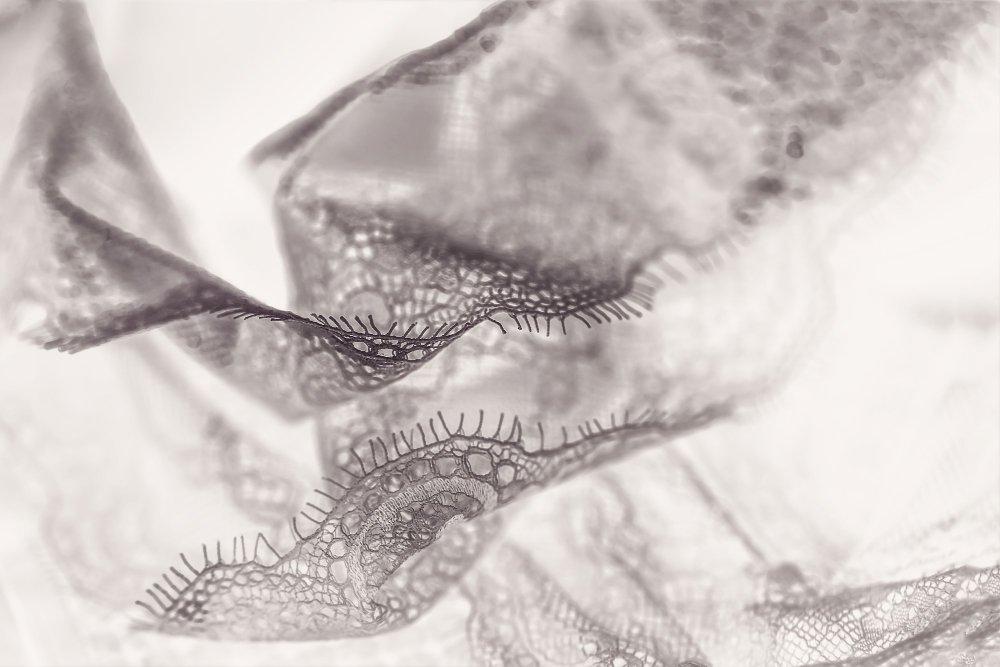From 15th-Century Tradition to 2025 Fashion: Your Complete Journey into Handmade Lace
Creating a single square inch of needle lace fabric can take over 40 hours of careful work. This amazing fact shows why this 15th-century art form remains one of the most respected types of textile craftsmanship in human history. Originally made for church garments and royal clothing, the technique turns simple thread into delicate patterns using nothing but a single needle.
Unlike bobbin lace methods that use multiple threads, needle lace builds designs stitch by stitch. The Metropolitan Museum of Art keeps rare 16th-century examples, showing floral designs and precise geometric patterns that still inspire modern creators. Over centuries, artisans developed these methods into dramatic three-dimensional forms during the Baroque period.
Today, this historic craft is getting new attention. Design houses like Oscar de la Renta have brought back its elegance in modern fashion, proving ancient techniques can work in today’s wardrobes. This guide shows you how patience and precision come together to create timeless works of art, explaining why generations continue to love this challenging yet rewarding practice.
Table of Contents
What You’ll Learn
- How to create needle lace using only a needle and thread
- The difference between needle lace and other lace fabric types
- Museum-quality techniques passed down through generations
- Modern applications in contemporary fashion and design
- Step-by-step instructions for your first needle lace project
- Professional tips for achieving perfect results
What is Needle Lace?
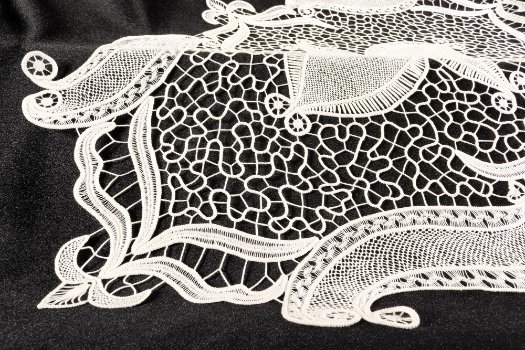
Needle lace is a type of openwork fabric created entirely with a needle and thread. You build the lace one stitch at a time on the surface, creating dimensional textures that seem to float above the material. This makes it different from regular embroidery, which goes through a base fabric.
Key Characteristics of Needle Lace
- Single Thread Construction: Unlike bobbin lace, needle lace uses just one continuous thread to form the entire piece.
- Surface Work: All stitches stay on top of the working surface rather than piercing through layers of fabric.
- Dimensional Design: The technique creates raised, sculptural effects that give depth and shadow to the finished piece.
- Portable Craft: You can work on needle lace anywhere since it requires minimal equipment and setup.
As Mary Brooks Picken noted, “This art form relies solely on a sewing needle, using stitches like buttonhole loops over a temporary framework.” This scaffolding method lets intricate floral designs or geometric shapes emerge without going through the base fabric.
As the Victoria and Albert Museum explains in their comprehensive lace documentation, needle lace represents the pinnacle of thread manipulation techniques, requiring exceptional skill to build dimensional fabric entirely from individual stitches. Their collection showcases examples spanning four centuries of needle lace evolution.
Regional Variations
Turkish Oya demonstrates how different cultures adapt core principles. Instead of thread outlines, it uses knots to create delicate edgings on scarves and garments. These variations prove how communities reinterpret the basic technique while keeping the craft’s essential spirit.
The Appeal of Needle Lace in Modern Times
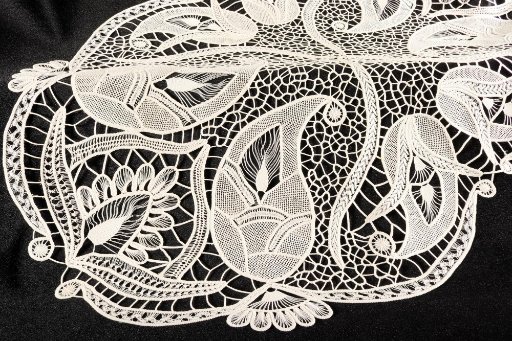
Modern creators love needle lace for its flexibility and portability. You can work anywhere, trying different stitches that range from dense fillings to airy net-like structures. French Alençon lace pieces show how raised stitches create dramatic shadows, while contemporary designers blend traditional methods with minimalist styles.
The appeal lies in balancing structure with creativity. You can control thread tension and stitch density to make works that feel both planned and organic. This is a rare quality in textile arts.
2025 Fashion Renaissance
Contemporary fashion has embraced needle lace in exciting new ways. Designers like Simone Rocha consistently feature needle lace elements, explaining that “the fabrication is so emotive and helps drive the necessary conversation between textile and silhouette.”
On the 2025 runways, needle lace appeared in:
- High-contrast designs: Black lace over bright-colored fabrics
- Minimalist applications: Subtle lace panels on structured garments
- Gothic romance: Dark, moody pieces channeling Victorian aesthetics
- Sustainable luxury: Eco-friendly versions using organic threads
Historical Development and Cultural Impact
Origins and Early Evolution (15th-16th Century)
Early forms emerged from embroidery methods around 1540. Initially, artisans used thick cords to join garment sections. By 1600, these practical elements became decorative. The Metropolitan Museum’s collection shows this shift through pieces like Claude de Lorraine’s collar, where geometric patterns evolved into floral designs.
Venice became a major center for needle lace making in the 1400s, as documented by official records. The technique developed from reticella, an openwork embroidery on linen that aristocrats used to display their wealth.
The Baroque Revolution (17th Century)
Baroque-era creators pushed boundaries with raised stitches that created depth. The fashion moved from simple geometric edgings to elaborate three-dimensional needle lace that seemed to float off the fabric. This period established needle lace as the preferred choice for court wear over simpler bobbin lace.
The Metropolitan Museum of Art’s textile collection demonstrates this evolution, showing how needle lace transformed from practical fastenings to elaborate court fashion between 1600-1800. Their documented pieces reveal the technical innovations that made needle lace the preferred choice for European aristocracy.
18th Century Refinements
Later, 18th-century designs favored lightweight nets decorated with delicate patterns. Each style reflected its era’s aesthetic values while maintaining core technical principles. The craft spread across Europe as immigrants brought their techniques to new countries, creating hybrid styles that mixed traditions.
The evolution of needle lace reflects changing fashion, technology, and social values across six centuries. This timeline shows how the craft transformed from practical necessity to luxury art form, and now to sustainable fashion statement
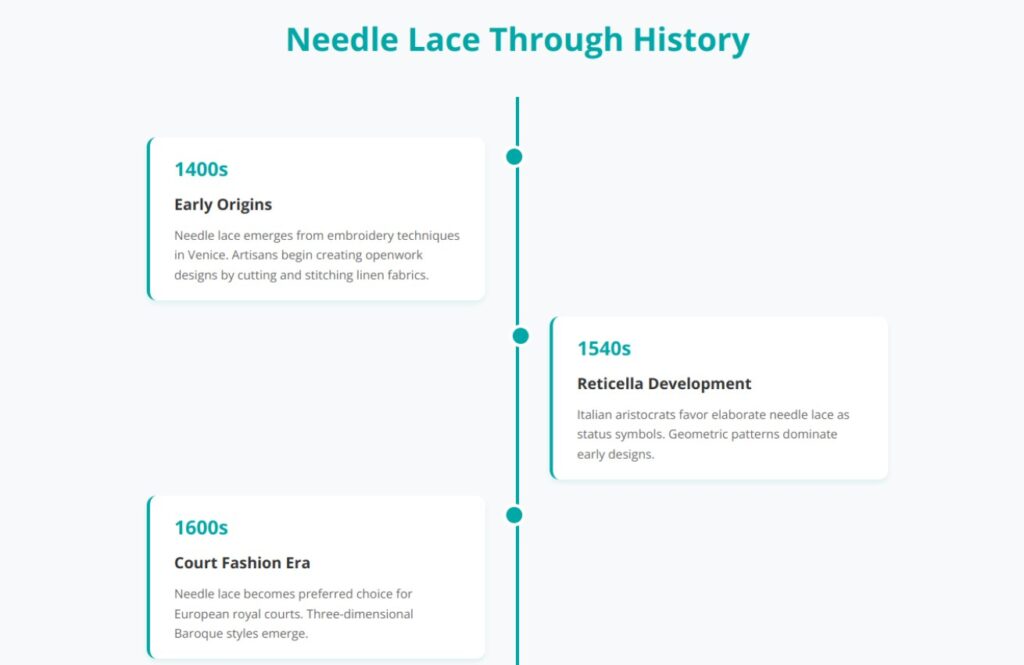
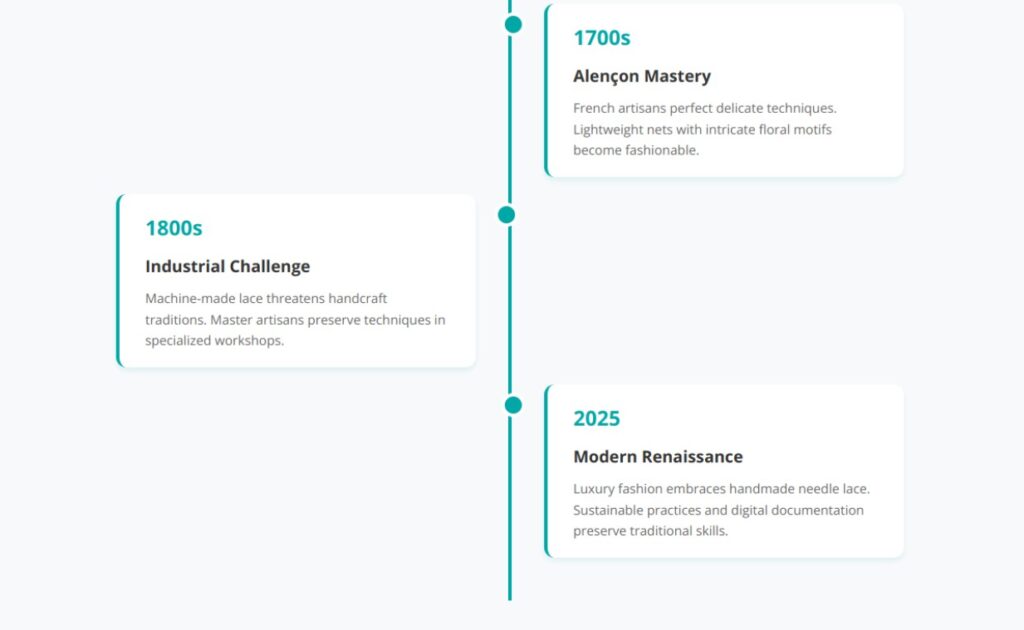
This historical progression shows needle lace’s remarkable adaptability. Each era brought new techniques and applications while preserving the fundamental skill of transforming thread into dimensional fabric through patient handwork
Modern Revival and Innovation
Today’s needle lace incorporates both traditional methods and contemporary innovations:
- AI-assisted pattern design: Modern technology helps create complex patterns while preserving artisan skills
- Sustainable materials: Organic cotton and recycled threads replace traditional options
- 3D printing integration: Some artists combine digital fabrication with hand techniques
- Fashion technology: Needle lace appears in smart textiles and wearable electronics
Essential Materials and Tools
Creating quality needle lace requires the right materials. Your choice of threads, needles, and supporting materials directly affects your final results.
Thread Selection Guide
| Thread Type | Best For | Thread Weight | Historical Use |
|---|---|---|---|
| Linen (NeL 35/2) | Structural outlines | Medium | Church vestments |
| Cotton (DMC 100) | Filling stitches | Fine | 18th-century gowns |
| Silk | Luxury pieces | Variable | Royal garments |
| Modern synthetics | Practice work | Variable | Contemporary applications |
Professional Tip: Start with cotton fabric threads for practice. They’re easier to handle and less expensive than silk or linen options.
Needle Requirements
You’ll need two types of needles for proper needle lace work:
Sharp Needles: For couching outline threads and temporary stitching
- Size 24-26 for fine work
- Size 22-24 for medium weight threads
Blunt Needles: For working the lace stitches themselves
- Tapestry needles prevent splitting existing stitches
- Ballpoint needles slide smoothly through loops
Supporting Materials
Pattern Foundation:
- Clay-coated paper for design visibility
- Transparent film to protect patterns
- Multiple fabric layers for stability
Working Surface:
- Firm fabric like muslin or cotton for backing
- Embroidery hoops for tension control
- Good lighting to see fine details clearly
What is the Best Thread for Needle Lace?
The best thread depends on your project goals and skill level. For beginners, DMC Pearl Cotton #12 offers good visibility and forgiveness. Advanced makers often prefer linen threads like NeL 35/2 for their strength and authentic historical feel.
Beginner Recommendations:
- DMC Pearl Cotton #12: Easy to see, handles well
- Madeira Cotona 30: Smooth finish, good for practice
- Anchor Pearl Cotton: Widely available, consistent quality
Advanced Options:
- Hand-spun linen: Most authentic, requires skill
- Silk threads: Beautiful finish, slippery to work with
- Specialty threads: Metallic or synthetic for modern effects
Consider thread characteristics:
- Twist: Tighter twist holds shape better
- Fiber content: Natural fibers age beautifully
- Color fastness: Important for white or light pieces
- Availability: Choose threads you can replace easily
Choosing the right thread dramatically affects your needle lace experience and results. Each thread type offers distinct advantages depending on your project goals and skill level.

Start with cotton threads for practice, then experiment with linen for authenticity or silk for luxury pieces. The thread you choose becomes part of your lace’s character and longevity.
Needle Lace vs. Bobbin Lace: Key Differences
Understanding the differences helps you choose the right technique for your projects.
Construction Method Comparison
| Aspect | Needle Lace | Bobbin Lace |
|---|---|---|
| Tools | Single needle + thread | Multiple bobbins + pillow |
| Thread count | One continuous thread | Many threads worked together |
| Portability | Highly portable | Requires dedicated workspace |
| Learning curve | Moderate | Steep initial setup |
| Design flexibility | Very flexible | Pattern-dependent |
| Historical preference | Court fashion | Folk traditions |
The tools required for each technique reveal why needle lace appeals to modern crafters. This comparison shows the practical advantages that make needle lace more accessible for beginners and travelers.
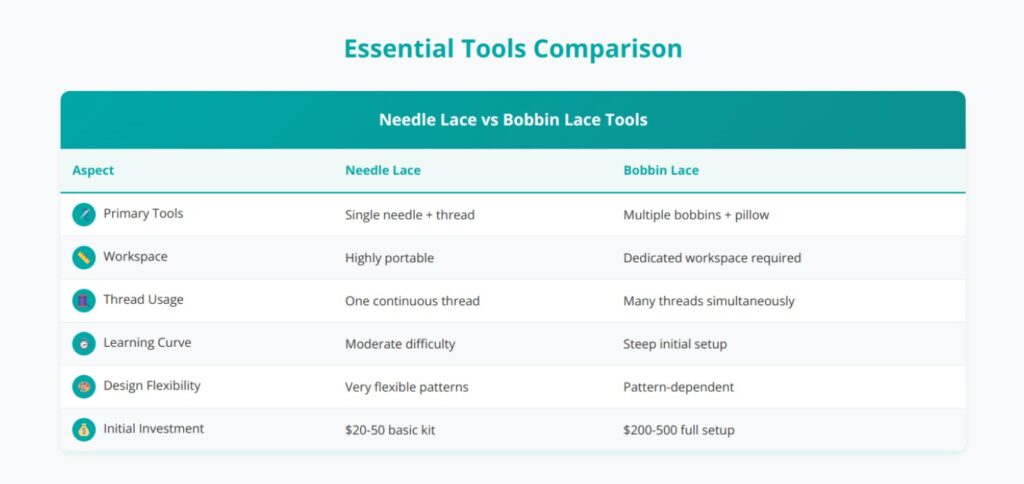
These differences explain why needle lace has seen renewed popularity among modern crafters. The minimal equipment requirements and creative freedom make it ideal for today’s mobile lifestyle.
When to Choose Each Technique
Choose Needle Lace for:
- Detailed floral motifs
- Three-dimensional effects
- Portable projects
- Historical reproductions
- Modern artistic interpretations
Choose Bobbin Lace for:
- Geometric patterns
- Continuous edgings
- Traditional folk designs
- Production speed
- Certain regional styles
Both techniques create beautiful results, but needle lace offers more creative freedom for individual expression.
Step-by-Step Needle Lace Techniques
Setting Up Your First Project
Start with a simple heart or flower shape. This teaches basic principles without overwhelming complexity.
Pattern Preparation:
- Draw your design on clay-coated paper
- Cover with transparent adhesive film
- Baste to two layers of foundation fabric
- Choose high-contrast threads for easy visibility
The Cordonnet Foundation
The cordonnet forms the skeleton of your needle lace. This doubled thread creates the outline that supports all filling stitches.
Step-by-Step Process:
- Cut thread twice the length of your pattern outline
- Fold in half to create doubled cordonnet
- Use contrasting sewing thread to couch down the outline
- Secure at junction points with special looping techniques
- Keep couching stitches close together for stability
Three Proven Filling Methods
Different teachers developed distinct approaches to filling needle lace shapes:
Michael Dennis Method
- Work from top to bottom
- Point needle toward yourself
- Use DMC Pearl #12 thread
- Creates bold, visible textures
- Best for beginners learning stitch control
Alençon Traditional Technique
- Work from bottom to top
- Wrap lace pad around index finger
- Point needle away from yourself
- Use finer threads like DMC Cordonnet #100
- Requires more skill but creates delicate results
Dillmont Historical Method
- Based on 1886 “Encyclopedia of Needlework”
- Variable direction depending on pattern
- Emphasizes reduced thread tangling
- Uses traditional stitch sequences
- Good for historical reproductions
Essential Stitch Techniques
Buttonhole Stitch Variations:
- Basic buttonhole: Foundation of most needle lace
- Corded buttonhole: Worked over a laid thread
- Grouped buttonhole: Multiple stitches in same space
- Picot buttonhole: Creates decorative points
Filling Patterns:
- Honeycomb: Regular geometric fill
- Spider web: Radiating circular pattern
- Bars: Straight connecting elements
- Net grounds: Open mesh backgrounds
Junction Points and Connections
Properly connecting different sections requires special techniques:
- Simple joining: Loop new thread through existing cordonnet
- Reinforced joining: Multiple loops for strength
- Decorative joining: Visible connection becomes design element
- Hidden joining: Seamless integration between sections
Finishing Techniques
Edge Wrapping:
- Cover cordonnet with tight buttonhole stitches
- Maintain consistent spacing and tension
- Create smooth curves at direction changes
- Hide thread ends securely
Removal from Foundation:
- Cut all temporary couching threads
- Gently lift lace from backing fabric
- Remove any remaining foundation threads
- Trim excess thread ends
- Block if necessary for shape correction
What Needle Do You Use to Lace Fabric?
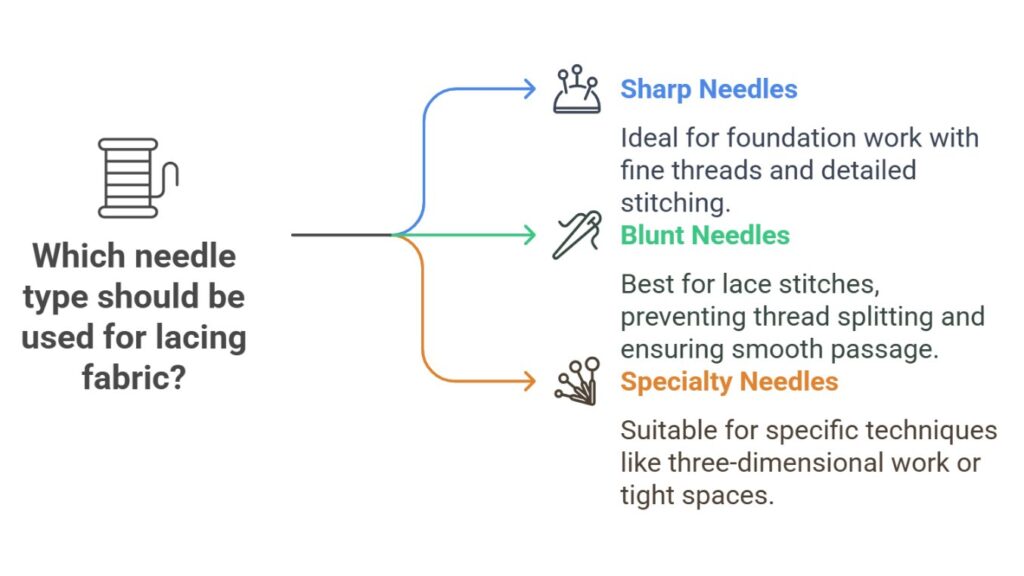
Needle selection affects both your working experience and final results. The right needle makes stitching smoother and prevents thread damage.
Sharp Needles for Foundation Work
For couching the cordonnet and temporary stitching:
- Size 24 Sharps: Best for fine threads and detailed work
- Size 22 Sharps: Good for medium-weight threads
- Quilting needles: Short length provides better control
Blunt Needles for Lace Stitches
For working the actual lace filling:
- Tapestry needles: Blunt tip won’t split existing threads
- Ballpoint needles: Slide smoothly through loops
- Chenille needles: Larger eye for thicker threads
Specialty Needles
- Curved needles: Useful for three-dimensional work
- Double-pointed needles: For working in tight spaces
- Bent-tip needles: Easier hand positioning for some techniques
Choose needle size based on your thread weight. The needle should pass through fabric easily without leaving large holes or struggling with thick thread.
Is Needle Lace the Same as Needle Tatting?
No, needle lace and needle tatting are completely different techniques, although both use a single needle and thread.
Key Differences
Needle Lace:
- Creates flat or dimensional fabric
- Uses buttonhole stitches primarily
- Worked over a foundation pattern
- Removes from backing when complete
- Historical origins in 15th-century embroidery
Needle Tatting:
- Creates chains and rings
- Uses double half-hitches exclusively
- Worked without foundation
- Creates three-dimensional structures
- Developed as needle version of shuttle tatting
Stitch Comparison
| Technique | Primary Stitch | Structure | Final Form |
|---|---|---|---|
| Needle Lace | Buttonhole variations | Flat openwork | Fabric-like |
| Needle Tatting | Double half-hitch | Rings and chains | Structural |
| Traditional Tatting | Same as needle | Shuttle-made | Identical to needle version |
Understanding these differences helps you choose the right technique for your desired outcome.
How Long Does Needle Lace Take?
Time requirements vary dramatically based on design complexity, thread fineness, and skill level.
Time Investment by Project Type
Simple Practice Motifs (2-3 inches):
- Beginner: 8-12 hours
- Intermediate: 4-6 hours
- Advanced: 2-3 hours
Detailed Floral Designs (4-5 inches):
- Beginner: 20-30 hours
- Intermediate: 12-18 hours
- Advanced: 8-12 hours
Museum-Quality Pieces (6+ inches):
- Any skill level: 40-100+ hours
- Professional reproduction: 200+ hours
- Master-level exhibition piece: 500+ hours
Factors Affecting Speed
Thread Weight: Finer threads require more stitches and time Design Complexity: More fills and details increase time significantly
Skill Level: Experience dramatically improves efficiency Working Conditions: Good lighting and comfort speed progress Pattern Preparation: Well-prepared foundations save time later
Realistic time planning prevents frustration and helps you choose appropriate projects for your schedule. These estimates account for the learning curve and complexity factors that affect working speed.
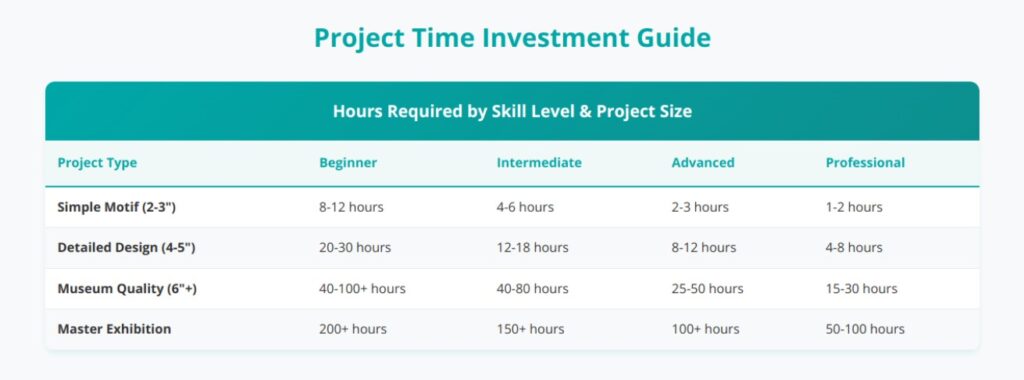
Remember that these are estimates – your actual time may vary based on thread choice, design complexity, and working conditions. Focus on enjoying the process rather than rushing to finish.
Time-Saving Tips:
- Start with larger thread weights
- Choose simple geometric patterns initially
- Work in good lighting conditions
- Take breaks to maintain stitch quality
- Keep consistent working rhythm
The “40 hours per square inch” statistic applies to museum-quality work with very fine threads. Most hobbyist projects take much less time per area.
How to Make Irish Needle Lace
Irish needle lace developed unique characteristics that distinguish it from Continental European styles. The technique emphasizes raised work and dimensional flowers.
Irish Technique Characteristics
Distinctive Features:
- Heavy use of raised work and padding
- Floral motifs with dimensional petals
- Combination with Irish crochet elements
- Emphasis on texture over geometric precision
- Often worked in sections and joined
Materials for Irish Style
Traditional Threads:
- Irish linen thread
- Cotton crochet thread for padding
- Silk for luxury pieces
Modern Substitutes:
- DMC Pearl Cotton for practice
- Anchor Artiste for similar weight
- Madeira Cotona for smooth finish
Step-by-Step Irish Motif
Creating a Traditional Irish Rose:
- Center Foundation:
- Work small circle in buttonhole stitch
- Pad with extra threads for dimension
- Create tight, firm center
- First Petal Layer:
- Work five loops around center
- Use corded buttonhole for texture
- Make each petal progressively larger
- Outer Petals:
- Add second layer of larger petals
- Use looser tension for natural curve
- Vary stitch density for shading effects
- Leaf Elements:
- Create separately using similar technique
- Add vein details with raised lines
- Attach to flower base when complete
Joining Irish Elements
Irish needle lace often combines separately-made elements:
- Brides: Connecting bars between motifs
- Mesh grounds: Open net backgrounds
- Corded joins: Raised connecting elements
This modular approach allows complex designs while keeping individual elements manageable.
Three distinct approaches to needle lace filling have emerged from different teaching traditions. Each method produces excellent results while suiting different learning styles and project goals.

Try each method with simple practice pieces to discover which approach feels most natural for your hands and working style. Many experienced lacemakers combine elements from different traditions.
Advanced Techniques and Modern Applications
Three-Dimensional Needle Lace
Modern needle lace pushes beyond flat applications into sculptural territory.
Dimensional Techniques:
- Stumpwork integration: Combining raised needlework with lace
- Wire reinforcement: Adding structure for permanent shaping
- Layered construction: Building depth through multiple levels
- Detached elements: Creating parts that extend beyond base fabric
Contemporary Design Innovations
Digital Pattern Integration: Modern designers use computer software to create precise patterns while maintaining hand-crafted execution.
Mixed Media Applications:
- Combining with beaded lace fabric techniques
- Integration with laser-cut elements
- Incorporation into wearable electronics
- Fashion technology applications
Sustainable Needle Lace Practices
Environmental consciousness influences modern needle lace:
Eco-Friendly Materials:
- Organic cotton threads
- Peace silk options
- Recycled synthetic fibers
- Natural fiber alternatives
Sustainable Practices:
- Minimal waste production
- Long-lasting heirloom pieces
- Local material sourcing
- Traditional skill preservation
Fashion Industry Applications
2025 Runway Trends: Needle lace appears in unexpected contexts:
- Athletic wear accents
- Streetwear applications
- Sustainable luxury collections
- Gender-neutral fashion design
Commercial Adaptations:
- Machine reproduction of hand techniques
- Hybrid hand-machine processes
- Limited edition artisan collaborations
- Custom couture applications
Troubleshooting Common Problems
Thread and Tension Issues
| Problem | Solution |
|---|---|
| Uneven stitch tension | Practice consistent hand position and thread control |
| Thread splitting during work | Use blunt needles for lace stitches, check thread quality |
| Visible gaps in filling | Adjust stitch spacing, use proper thread weight for pattern |
Pattern and Foundation Problems
| Problem | Solution |
|---|---|
| Pattern distortion during work | Better foundation preparation, proper backing tension |
| Difficulty removing from foundation | Use contrasting couching thread, avoid tight temporary stitches |
| Cordonnet pulling out of shape | More frequent anchoring points, proper thread weight selection |
Finishing Difficulties
| Problem | Solution |
|---|---|
| Uneven edge finishing | Consistent buttonhole stitch tension, proper needle angle |
| Loose connections between sections | Reinforce junction points, use proper joining techniques |
| Final piece doesn’t lay flat | Proper blocking techniques, check foundation fabric stretch |
Care and Preservation
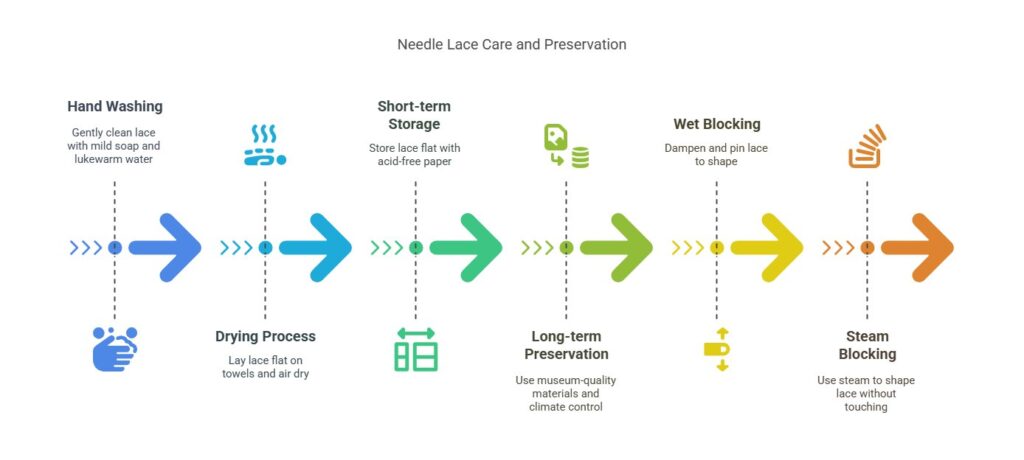
Cleaning Needle Lace
Hand Washing:
- Use lukewarm water with mild soap
- Support wet lace carefully to prevent distortion
- Never wring or twist delicate areas
- Rinse thoroughly to remove all soap residue
Drying Process:
- Lay flat on clean towels
- Shape gently while damp
- Avoid direct sunlight
- Allow complete air drying
Storage Methods
Short-term Storage:
- Acid-free tissue paper
- Flat storage in drawers
- Protection from light exposure
- Stable temperature and humidity
Long-term Preservation:
- Museum-quality storage materials
- Climate-controlled environment
- Regular inspection for deterioration
- Professional conservation if needed
Blocking and Shaping
Wet Blocking:
- Dampen evenly with spray bottle
- Pin to shape on blocking board
- Use rust-proof pins
- Allow complete drying before removal
Steam Blocking:
- Hold steam iron above work (don’t touch)
- Shape while warm and pliable
- Work in small sections
- Cool completely before handling
What are the Best Needles for Lace?
Choosing the right needles can make or break your needle lace experience. Quality needles improve your stitching accuracy and reduce hand fatigue.
Top Needle Brands for Lace Work
Premium Options:
- John James needles: Excellent point retention, smooth shafts
- Bohin needles: French quality, precise sizing
- Clover needles: Comfortable to hold, good for arthritis
Budget-Friendly Choices:
- Dritz needles: Widely available, adequate quality
- Singer needles: Basic functionality, affordable
- Generic craft store brands: Good for practice work
Needle Size Recommendations by Thread Weight
| Thread Weight | Sharp Needle Size | Blunt Needle Size | Best Brand Choice |
|---|---|---|---|
| Very Fine (100+) | 26-28 | 26-28 tapestry | John James |
| Fine (60-80) | 24-26 | 24-26 tapestry | Bohin |
| Medium (40-60) | 22-24 | 22-24 tapestry | Clover |
| Heavy (20-40) | 20-22 | 20-22 tapestry | Any quality brand |
Needle Care and Maintenance
Keeping Needles Sharp:
- Store in needle books or cases
- Avoid dropping on hard surfaces
- Replace when points become dull
- Clean with fine abrasive if needed
Preventing Rust:
- Store in dry conditions
- Use needle protectors
- Keep away from moisture
- Consider stainless steel options
Quality needles are an investment that improves your work dramatically. Start with one good set rather than many cheap ones.
Building Your Needle Lace Skills
Beginner Project Progression
Project 1: Simple Leaf (2-3 hours)
- Practice basic buttonhole stitches
- Learn cordonnet preparation
- Understand foundation removal
Project 2: Small Flower (4-6 hours)
- Multiple filling patterns
- Junction point techniques
- Edge finishing methods
Project 3: Connected Motifs (8-12 hours)
- Joining separate elements
- Background ground work
- Complex pattern reading
Intermediate Challenges
Dimensional Work:
- Raised petals and leaves
- Wire integration techniques
- Stumpwork combinations
Historical Reproductions:
- Research museum pieces
- Match period techniques
- Use authentic materials
Advanced Mastery
Original Design Creation:
- Develop personal style
- Create custom patterns
- Experiment with materials
Teaching and Sharing:
- Document your techniques
- Share knowledge with others
- Preserve traditional methods
Modern Resources and Learning
Online Learning Platforms
Video Tutorials: Modern platforms offer excellent needle lace instruction from experts like Michael Dennis and Cathy Monier. These detailed demonstrations show finger positioning and stitch formation clearly.
Digital Pattern Libraries:
- Historical pattern digitization projects
- Contemporary designer collections
- Free and paid pattern resources
- Interactive pattern generators
Books and Publications
Essential References:
- “A Practical Guide to Needle Lace” by Jacqueline Peter
- “Needle Lace: Techniques & Inspirations” by Jill Nordfors Clark
- Historical technique manuals and reproductions
Magazines and Journals:
- PieceWork magazine regular features
- International lace society publications
- Contemporary fiber art magazines
Workshops and Communities
In-Person Learning:
- Local needlework guilds
- Museum workshops
- Art center classes
- Master artisan intensives
Online Communities:
- Social media groups
- Forum discussions
- Virtual workshops
- Skill-sharing platforms
The Future of Needle Lace
Technology Integration
- Digital Design Tools: Computer-aided design helps create complex patterns while preserving hand execution. AI assistance can generate variations while respecting traditional principles.
- Documentation Projects: Digital archives preserve techniques that might otherwise disappear. Video documentation captures subtle hand movements that written instructions miss.
Contemporary Relevance
- Fashion Applications: Luxury brands increasingly value handmade elements in a digital world. Needle lace provides authenticity and uniqueness that machines cannot replicate.
- Therapeutic Benefits: The meditative nature of repetitive stitching offers stress relief and mental health benefits, making needle lace attractive to new audiences seeking mindful activities.
- Cultural Preservation: Active practice keeps traditional techniques alive while allowing for contemporary interpretation and innovation.
Conclusion
The journey into needle lace offers far more than learning a craft technique. You’re connecting with centuries of human creativity, patience, and artistic expression. From the medieval artisans who first transformed practical stitching into decorative art, to today’s fashion designers revolutionizing runways with handmade elements, needle lace bridges past and future.
Key Takeaways for Success
- Start Simple: Begin with basic motifs using medium-weight threads. Master fundamental techniques before attempting complex historical reproductions or original designs.
- Invest in Quality Tools: Good needles, proper threads, and suitable working surfaces make the difference between frustration and enjoyment. Your tools should support your creativity, not hinder it.
- Embrace the Process: The “40 hours per square inch” statistic shouldn’t intimidate you. Each stitch builds skill and understanding. The meditative rhythm of needle lace provides benefits beyond the finished piece.
- Connect with Community: Whether through online forums, local guilds, or workshop classes, sharing your journey enriches the experience. The needle lace community welcomes newcomers and celebrates shared knowledge.
Modern Applications and Opportunities
Today’s needle lace extends beyond traditional boundaries. Contemporary fashion embraces handmade elements as luxury alternatives to mass production. From sustainable fashion trends to artisan collaborations, needle lace finds new relevance in a digital world hungry for authentic human expression.
The technique’s portability makes it perfect for modern lifestyles. Unlike many crafts requiring dedicated workspace, needle lace travels easily. You can work during commutes, waiting periods, or quiet evenings, building beautiful pieces gradually over time.
Preserving and Innovating
Your needle lace practice contributes to cultural preservation while allowing personal innovation. Each piece you create adds to the living tradition, whether you follow historical patterns or develop contemporary interpretations.
The skills you develop transfer to other textile arts and creative pursuits. Understanding thread behavior, tension control, and pattern development enhances any fabric-related project.
Looking Forward
As fashion continues embracing handmade elements and sustainable practices, needle lace offers both environmental benefits and artistic satisfaction. The technique produces minimal waste, creates lasting pieces, and uses simple materials available worldwide.
Whether you aim to create museum-quality reproductions, develop contemporary art pieces, or simply enjoy a relaxing hobby, needle lace rewards patience with beauty. Your first uneven stitches will improve with practice, each project teaching new skills and building confidence.
The ancient art of needle lace continues evolving through each practitioner’s hands. By learning these time-tested techniques, you join a tradition that spans centuries while creating something uniquely yours. In a world of mass production and digital interaction, the simple act of transforming thread into lace through human skill becomes both radical and profound.
Start your needle lace journey today. Gather your materials, choose a simple pattern, and take your first stitches into this remarkable craft. The techniques await your discovery, and the tradition welcomes your contribution.
Recommended Next Steps:
- Source basic materials from quality suppliers
- Start with a simple leaf or flower pattern
- Connect with local or online needle lace communities
- Document your progress for future reference
- Explore historical pieces for inspiration and technique study

